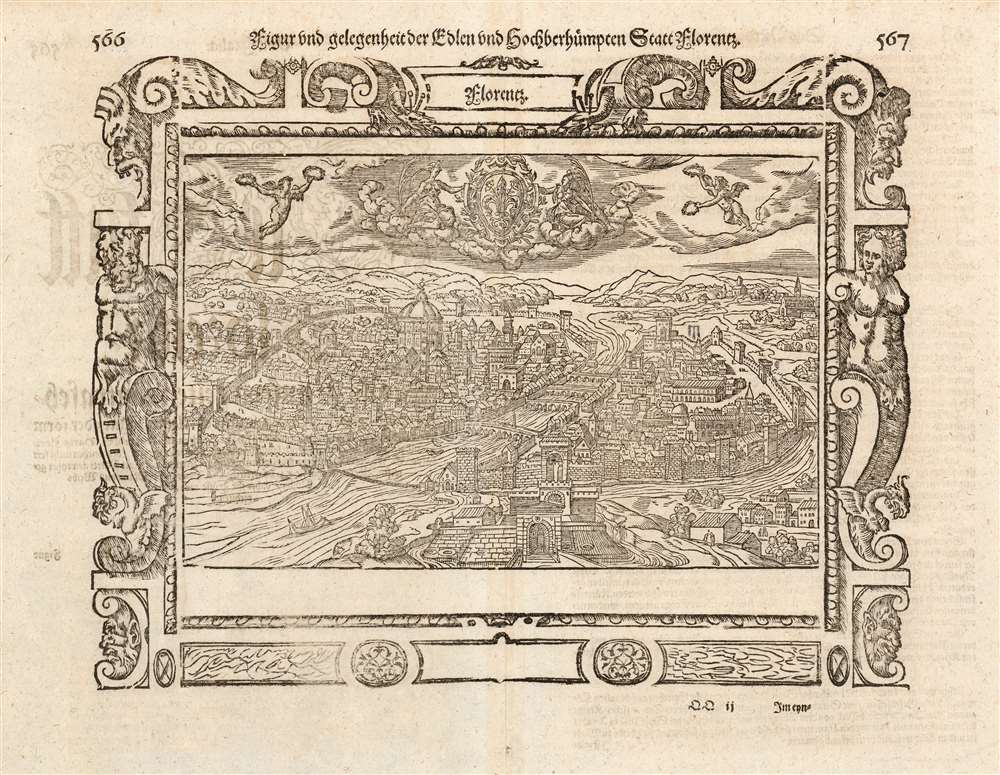1614 Munster View of Florence, Italy
Florence-munster-1614
Title
1614 (undated) 10 x 12.75 in (25.4 x 32.385 cm)
Description
Despite the late date of this example, it was one of the earliest printed views of the city. At the time of its addition to the work in 1572, it was preceded in print only by the view from Hartmann Schedel's 1493 Liber chronicarum and the 1550 view in Münster's Cosmographia which the present work replaced. The same year of 1572 saw the publication of Braun and Hogenberg's city book, which also included a view of Florence - but the two have no resemblance, and one is not a copy of the other. Münster's publishers and heirs, Heinrich and Sebastian Petri, appear to have used the author's original map as the model for this woodcut. The main changes to that view are decorative elements: the ornate border woodcuts, the two winged Victories presenting the city with laurels, and (top and center,) the city coat of arms, flanked by two women with palm branches: also avatars of triumph.
Publication History and Census
This woodcut panorama of the city of Florence appeared first in the 1572 Latin edition of Münster's Cosmographia, where it replaced an earlier woodcut depicting the city. The woodcut remained in the work throughout the rest of the printing history of the book. Münster's Cosmographia was a popular work, and as many as fifty thousand were printed. While many of these did not survive, individual maps do appear on the market from time to time. The separate woodcut is appears in six entries in OCLC, although the full work is well represented in institutional collections. The typography of this specific example is consistent with the 1614 German edition of Cosmographei.CartographerS
Sebastian Münster (January 20, 1488 - May 26, 1552), was a German cartographer, cosmographer, Hebrew scholar and humanist. He was born at Ingelheim near Mainz, the son of Andreas Munster. He completed his studies at the Eberhard-Karls-Universität Tübingen in 1518, after which he was appointed to the University of Basel in 1527. As Professor of Hebrew, he edited the Hebrew Bible, accompanied by a Latin translation. In 1540 he published a Latin edition of Ptolemy's Geographia, which presented the ancient cartographer's 2nd century geographical data supplemented systematically with maps of the modern world. This was followed by what can be considered his principal work, the Cosmographia. First issued in 1544, this was the earliest German description of the modern world. It would become the go-to book for any literate layperson who wished to know about anywhere that was further than a day's journey from home. In preparation for his work on Cosmographia, Münster reached out to humanists around Europe and especially within the Holy Roman Empire, enlisting colleagues to provide him with up-to-date maps and views of their countries and cities, with the result that the book contains a disproportionate number of maps providing the first modern depictions of the areas they depict. Münster, as a religious man, was not producing a travel guide. Just as his work in ancient languages was intended to provide his students with as direct a connection as possible to scriptural revelation, his object in producing Cosmographia was to provide the reader with a description of all of creation: a further means of gaining revelation. The book, unsurprisingly, proved popular and was reissued in numerous editions and languages including Latin, French, Italian, and Czech. The last German edition was published in 1628, long after Münster's death of the plague in 1552. Cosmographia was one of the most successful and popular books of the 16th century, passing through 24 editions between 1544 and 1628. This success was due in part to its fascinating woodcuts (some by Hans Holbein the Younger, Urs Graf, Hans Rudolph Manuel Deutsch, and David Kandel). Münster's work was highly influential in reviving classical geography in 16th century Europe, and providing the intellectual foundations for the production of later compilations of cartographic work, such as Ortelius' Theatrum Orbis Terrarum Münster's output includes a small format 1536 map of Europe; the 1532 Grynaeus map of the world is also attributed to him. His non-geographical output includes Dictionarium trilingue in Latin, Greek, and Hebrew, and his 1537 Hebrew Gospel of Matthew. Most of Munster's work was published by his stepson, Heinrich Petri (Henricus Petrus), and his son Sebastian Henric Petri. More by this mapmaker...
Heinrich Petri (1508 - 1579) and his son Sebastian Henric Petri (1545 – 1627) were printers based in Basel, Switzerland. Heinrich was the son of the printer Adam Petri and Anna Selber. After Adam died in 1527, Anna married the humanist and geographer Sebastian Münster - one of Adam's collaborators. Sebastian contracted his stepson, Henricus Petri (Petrus), to print editions of his wildly popular Cosmographia. Later Petri, brought his son, Sebastian Henric Petri, into the family business. Their firm was known as the Officina Henricpetrina. In addition to the Cosmographia, they also published a number of other seminal works including the 1566 second edition of Nicolaus Copernicus's De Revolutionibus Orbium Coelestium and Georg Joachim Rheticus's Narratio. Learn More...

